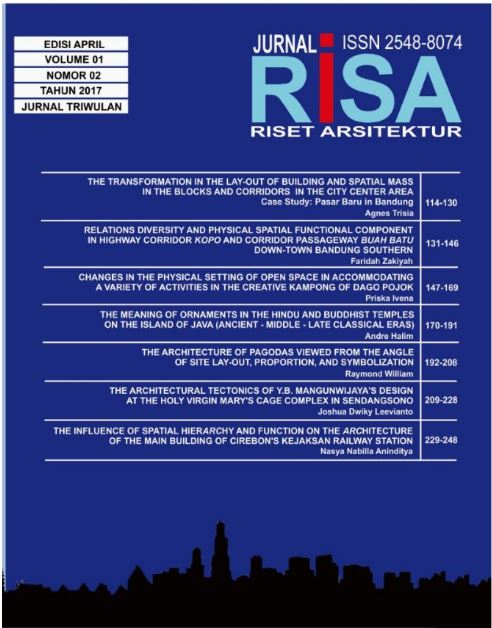RELATIONS DIVERSITY AND PHYSICAL SPATIAL FUNCTIONAL COMPONENT IN HIGHWAY CORRIDOR AND CORRIDOR PASSAGEWAY KOPO STONES DOWN-TOWN BANDUNG SOUTHERN
DOI:
https://doi.org/10.26593/risa.v1i02.2389.131-146Abstrak
Abstract- Having been an autonomous region since 1906, Bandung has experienced continuous expansion. One factor pushing this development was the construction of a road network connecting Bandung with its surrounding towns, yielding a variety of spatial and functional physical elements in urban space. This research study examines the architectural development of the southern part of Bandung, located on Jalan Raya Kopo and Jalan Terusan Buah Batu from 1996 until 2015 by analyzing the transformation that occurred, using the typo-morphological method, and by determining the correlation between the functional elements (land use or exploitation and the spatial-physical component of buildings and land parcels known as kaveling of their scope (height, mass lay-out, area width and type of lot). The tendency of the the area’s expansion in each of the street corridors can be analyzed through determining the correlation between these components covering the variety and dominant character or features observed. Jalan Raya Kopo shows a tendency toward a commercial trade-bound function whose mass type consists of one storey situated on the land parcel on the roadside in the middle of small lots. On the other hand, the extension of Jalan Terusan Buah Batu shows a functional tendency toward mixed use featuring a two-storied building mass on a land parcel on the roadside positioned in the middle of small lots. A change has been discernible in the actual planning of the spatial pattern from a purely residential area into a merger between commercial or industrial occupancy, in addition to the increasing density of the area and its soaring skyline.
Keywords: Urban architecture, physical, spatial, street corridor












